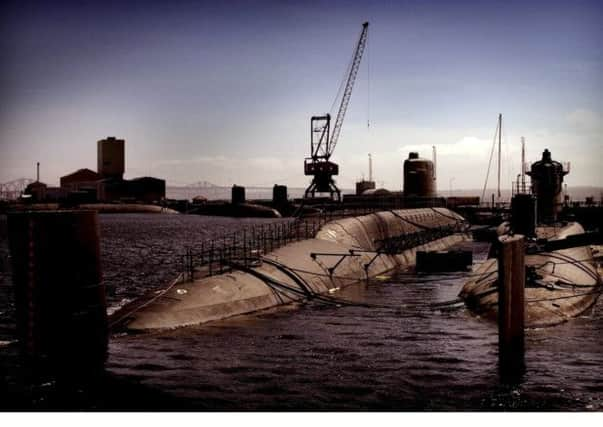Taxpayers get bill for Rosyth’s nuclear graveyard


The bill for maintaining and storing the seven subs at Rosyth dockyard has run to £13.5 million over the past five years, according to data released under freedom of information legislation.
Environmental groups described the sum as an “eye-watering” but those who represent Rosyth’s constituents stressed that the money was going into the region’s economy.
Advertisement
Hide AdAdvertisement
Hide AdWhereas the bill for Rosyth and the only other storage site, Devonport in Plymouth, was £200,000 in 2002/3, a decade later it spiralled to £3.9m.
Between 1998 and 2005, the annual cost for looking after subs at both sites never exceeded £2.5m, but in 2011/12 it cost £4.6m, then £3.8m the following year. The total cost for both sites over the last five years stands at £16.6m.
The ageing subs berthed at Rosyth’s non-tidal basin pre-date the Trident-carrying Vanguard class. They include HMS Dreadnought, the UK’s first nuclear powered sub, which was taken out of service in 1980.
Patrick Harvie, co-convener of the Scottish Green Party, said: “The rising costs of simply storing these hulks shows just how short-sighted Ministry of Defence thinking is when it comes to its nuclear arsenal.
“The hundred billion pound cost of renewing Trident over the next decade seems eye-watering enough but it’s clear that it would only be the start. The long-term legacy of commissioning, maintaining, storing and then decommissioning will continue to rise as Westminster insists on building new generations of these killing machines.”
Maintenance costs at Rosyth have risen of late due to expensive hull preservation work on six subs. The work is carried out by Babcock for the MoD.
Rosyth is expected to lead a pilot project to break up Britain’s old nuclear submarines. It is expected the pilot will be completed by around 2019, with one submarine a year dismantled thereafter. Work will not begin until a storage facility for the waste is identified.
Labour’s Thomas Docherty, who is fighting to retain the Dunfermline and West Fife seat at next month’s General Election, said the cost of the maintenance work went directly into the Fife economy.
Advertisement
Hide AdAdvertisement
Hide AdHe said: “It’s absolutely important the MoD justifies spending taxpayers’ money but that £13m is thankfully money that’s being spent at Rosyth dockyard and is employing local people.
“One of the things I’ve been talking to both the MoD and Babcock about is ensuring those decommissioning skills are delivered by local workers rather than having to bring them in from elsewhere in the UK.”
But Dr Richard Dixon, director of Friends of the Earth Scotland, said: “The cost of storing and keeping these subs safe has gone from expensive to eye-watering. The MoD needs to explain to the taxpayer how the costs have risen so spectacularly over the last decade.”
A spokesman for the MoD said: “These costs have inevitably changed over time as submarines age and more of them have come out of service and need to be stored and maintained prior to dismantling.
“We have made this clear in our public consultation documents dating back to 2011. There is an approved budget and the project is closely monitored.”